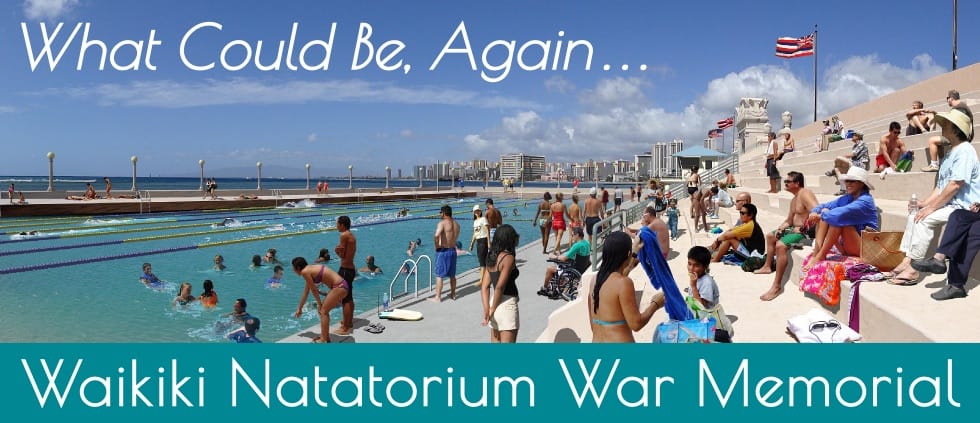Great news! The Honolulu chapter of the American Institute of Architects – in a guest column in the Nov. 17 Honolulu Star-Advertiser – issued a strong, eloquent call for restoration of the War Memorial Natatorium, our “living and permanent memorial” to Hawaii’s World War I soldiers and sailors.
The AIA cites the observation of Arthur Frommer: “Tourism does not go to a city that has lost its soul.”
“By restoring the Natatorium,” the AIA concludes, “we will fulfill our original promise to honor those who served in The Great War, preserve an essential piece of our soul, and allow the public to use and enjoy a unique ocean resource in Hawaii.”
If you have a Star-Advertiser subscription, please read the op-ed here and leave a comment on the newspaper’s website. If you don’t, you can read the text below. Please share this with your ohana and friends!
And mahalo to our friends at the AIA for taking this principled and important stand for our island’s architectural and cultural heritage.
From the Star-Advertiser:
Restore Natatorium and restore our soul
As stated in its public policies, the American Institute of Architects Honolulu Chapter (AIA Honolulu) supports the preservation of Hawaii’s significant historic buildings, sites and districts. Hawaii’s rich cultural past is represented by the structures constructed by various populations over the course of the islands’ habitation.

1973 Star-Advertiser photo of the Natatorium.
These physical remains of the past act as landmarks of our history and anchors for our future. They are part of the soul of our state, transcending generations and conveying multi-sensory messages to current and future generations about our past. Based on this policy, AIA Honolulu supports the preservation and restoration of the Waikiki Natatorium in its present location.
The War Memorial Natatorium, as it was officially known, was built as a living and permanent memorial to honor the men and women of Hawaii who served in The Great War (WWI).
After its opening, the Natatorium became an icon of the Waikiki shoreline and of Hawaii’s ocean sports legacy. The [100-meter] pool was a training venue for local Olympians, including Duke Kahanamoku, who swam the first lap and won a total of five medals — including three golds — in three different Olympics. The pool is a place where generations of Hawaii’s keiki have learned to swim.
The ocean sunset-facing bleachers and broad pool deck were a popular public gathering place and promenade whose design was unique among war memorials of its era. Its arched entrance facade and sculpted plaster ornaments are among the few remaining examples of Beaux Arts architecture in Hawaii.
The Natatorium is listed on both the National and Hawaii Register of Historic Sites. In 1996 it was named one of the “10 most endangered” historic sites in the country by the National Trust for Historic Preservation.
Full restoration of the Natatorium was begun in 1999 by Mayor Jeremy Harris but was stopped in 2001 over questions of water quality in the pool. The bleachers, colonnade, lifeguard offices and restrooms were restored, but the pool deck and ocean walls were not addressed.
Since that time several ideas for the pool have been raised, from using circulated ocean water, to using fresh chlorinated water, to covering the entire pool with a “beach” for volleyball or sightseeing.
AIA Honolulu favors a solution in which the original Natatorium structure and design are retained so that the public can walk through it and enjoy it as a living memorial. The first step in retention is the stabilization of the ocean walls and pool deck. With this underway, the treatment of the pool can be debated and evaluated using the latest scientific and medical information and most cost-effective marine construction methods.
Author and tourism expert Arthur Frommer has written, “Tourism does not go to a city that has lost its soul.” Given the importance of tourism to our state, we should heed that advice. The Natatorium was a prominent part of Hawaii’s history for more than half a century, and it should be treasured as both a waterfront memorial and a public amenity. Its unique style and structure have far greater value to residents and visitors than the alternative of creating a new beach.
AIA Honolulu encourages the state of Hawaii, the City & County of Honolulu, private and philanthropic interests to work together to stabilize the ocean portion of the Natatorium in order to preserve as many options for returning the memorial to public use and access as possible.
By restoring the Natatorium, we will fulfill our original promise to honor those who served in The Great War, preserve an essential piece of our soul, and allow the public to use and enjoy a unique ocean resource in Hawaii.
Louis Fung is 2013 president of The American Institute of Architects-Honolulu Chapter.

David Yester
I think it should be restored to its past glory. They have many salt water pools in Australia by the coastline, so it couldn’t that difficult. So many times I just hear politicians so why it won’t work instead of trying to find a solution to make it work. We owe it to our Veteterans and the people of Hawaii.
admin
Mahalo for your incisive comment!